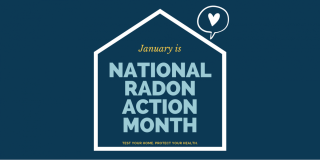National Radon Action Month 2020

Radon is a naturally occurring, radioactive gas released in rock, soil, and water formed from the breakdown of uranium. Levels in outdoor air pose a low threat to human health. However, radon can enter homes from surrounding soil and become a health hazard inside buildings. Radon does not cause symptoms. You can’t see it or smell it, but an elevated radon level in your home may be affecting the health of your family.
Radon is the second leading cause of lung cancer deaths in the U.S., and the first leading cause among non-smokers, claiming more than 20,000 lives annually. The East Hartford Health Department urge all residents to protect their health by testing their homes for radon.
Exposure to radon is a preventable health risk and testing radon levels in your home can help prevent unnecessary exposure. The Environmental Protection Agency (EPA) recommends reducing radon levels in the home’s indoor air to below 4 picocuries per liter (pCi/L). The only way to know if you have an elevated radon level above the action level of 4 pCi/L is to test your home’s indoor air.

How to Test Your Home
Testing your home is easy to do and should only take a few minutes of your time. It’s as easy as opening a package, placing a radon detector in the basement or on the first floor, and, after 2 to 7 days, sending the detector to a lab for analysis. The lab will then send you the radon test result within a few weeks.
Radon Testing Checklist for the Home (Source: Connecticut Department of Public Health)
This checklist will help you accurately test for radon in your home’s indoor air. Follow the instructions included with your test device.
- Test for radon in the lowest frequently occupied area of your home during the colder months (November through March)
- Place the test device in a room on the first floor if that is the lowest level of the home that you use regularly
- Place the test device in the basement if you use the space three or more hours each day or if you plan to renovate and occupy that space more often in the near future
- Windows should be kept closed for 12 hours before testing and throughout testing (48+ hours)
- All doors to the outside should be kept closed as much as possible during the test (except when people are leaving or entering)
- To BEGIN your test:
- Open the test device
- You MUST write the “start date” and “start time” on the lab form
- Place the test device between 2 to 6 feet above the floor and at least 3 feet away from doors and windows
- Leave the test device in place for a minimum of 48 hours to a maximum of 7 days
- The lab cannot analyze the device unless it has been exposed for at least 2 days. The lab will NOT analyze your test if it is exposed for longer than 7 days
- To END your test:
- Close and seal tightly
- Complete the lab form by answering all questions
- You MUST write the date and time that you closed up your test device. The lab cannot analyze the device if dates and times are missing
- Mail the test device with the lab form to the laboratory immediately
For additional testing information, review the full checklist here.
If you prefer to hire a professional to perform a confirmatory radon test in your home, visit the CT DPH Radon Program website for a list of radon measurement professionals.
You can also purchase a low cost test kit from the American Lung Association of New England by calling 1-800-LUNG-USA (1-800-586-4872) or by visiting lung.org.
For any additional questions, please contact the East Hartford Health Department at 860-291-7324.

